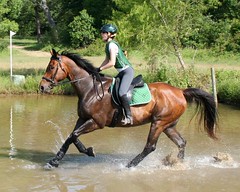I started researching my feed in detail because Saga has been somewhat footy, off-and-on since I took his shoes off earlier this year. Excess sugar and non-structured carbohydrates (NSCs) are two known causes of laminitis, and low-grade laminitis seems to be the most common cause of footiness in barefoot horses. It affects shod horses too, but for various reasons* doesn't manifest in a noticeably "off" horse.
I also started researching feed because Red tied up after our last go at foxhunting. The attending vet suggested that he might be deficient in Vitamin E and Selenium, so I put Red on a supplement at the vet's recommendation. And then, somewhat belatedly, I started on my research.
If you start researching what your horse is eating, you realize very quickly that there are a lot of variables involved. How much hay, how much grain? Are you feeding alfalfa? What about supplements? How much should you be feeding of each? How much NSCs is he getting? What's the nutrient content of what your horse is eating versus what your horse is supposed to get on a daily basis? Is he getting too much? Too little? The math gets complicated quickly, and the information sources can be highly variable, so you really have to do your homework.
Over the next few posts, I'm going to break down what I've figured out for my boys, step-by-step, and provide all the calculations I've used so that you can figure it out for your horses as well. The first step is figuring out what our horses should actually be eating, in terms of weight of dry matter. Here's what Google has to say:
- Horses should eat 2 to 2.2 pounds of feed for every 100 pounds of body weight (Feeding Horses)
- Horses should eat the equivalent of 1.5 to 2.5 percent of their body weight as dry matter per day (this includes forage and grain) (Feeding Management for Horse Owners)
- Horses should receive no more than 0.5 to 1.0 percent of their body weight per day as concentrates (Basics of Feeding Horses: Feeding Management)
- Horses should be fed between 1.5 percent and 3.0 percent of their body weight per day in total feed. Each concentrate meal should not exceed 0.5% of total body weight (Stretching Your Horse’s Hay Supply During Drought)
- For adult horses, maintenance is about 1.5-2% body weight (Digestive System of the Horse and Feeding Management)
Red
Red is 14.2 hh, an "easy keeper," and in light work. By light work, I mean he works 3-4 hours per week at things like trail riding, dressage, and jumping. We do some conditioning with him, but it's not too strenuous even though we hunt. Ideally I'd like for him to be better conditioned, but there's that time factor. I estimate that Red weighs 900 lbs.
According to our math, Red should get between 13.5 and 22.5 lbs of feed per day, with no more than 9 lbs of concentrates.
Saga
Saga is 16.2 hh, a "hard keeper," and also in light work. I estimate that he weighs about 1100 lbs.
According to our math, Saga should between 16.5 and 27.5 lbs of feed per day, with no more than 11 lbs of concentrates.
Your horse
To calculate how much feed your horse should be getting, here's the formulas:
- Minimum total weight of feed = (Body weight in pounds) x 0.015
- Maximum total weight of feed = (Body weight in pounds) x 0.025
- Maximum total weight of concentrates = (Body weight in pounds) x 0.010
Coming up next...
So now we know how much in dry weight each of the boys should get, but how much are they actually getting? Your homework is to go weigh your grain, hay, and whatever else your horse gets in a day and write it all down. While you're at it, grab the tags off your feed bag and supplements, and ask your forage supplier if they test their forage, and if so, would they share that information with you. I'll be doing the same, and we'll compare notes in the next installment.
* I'll discuss these reasons in more detail in another post.








So how do you weigh hay? I guess I could drag the hay in, or the bathroom scale out, and weigh it that way...
ReplyDeleteI dragged the bathroom scale out to the feed shed. Fortunately, my hubby hasn't noticed that it's missing yet...
ReplyDelete